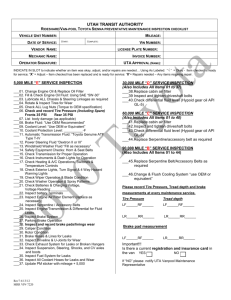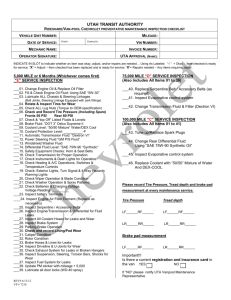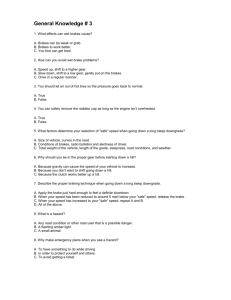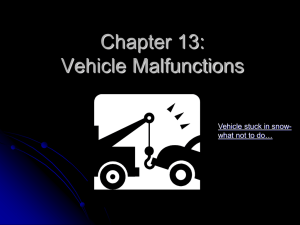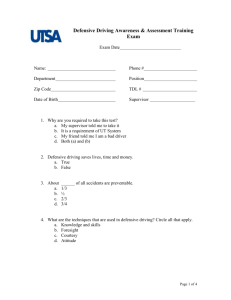Automotive Maintenance and Light Repair 3 Syllabus
advertisement
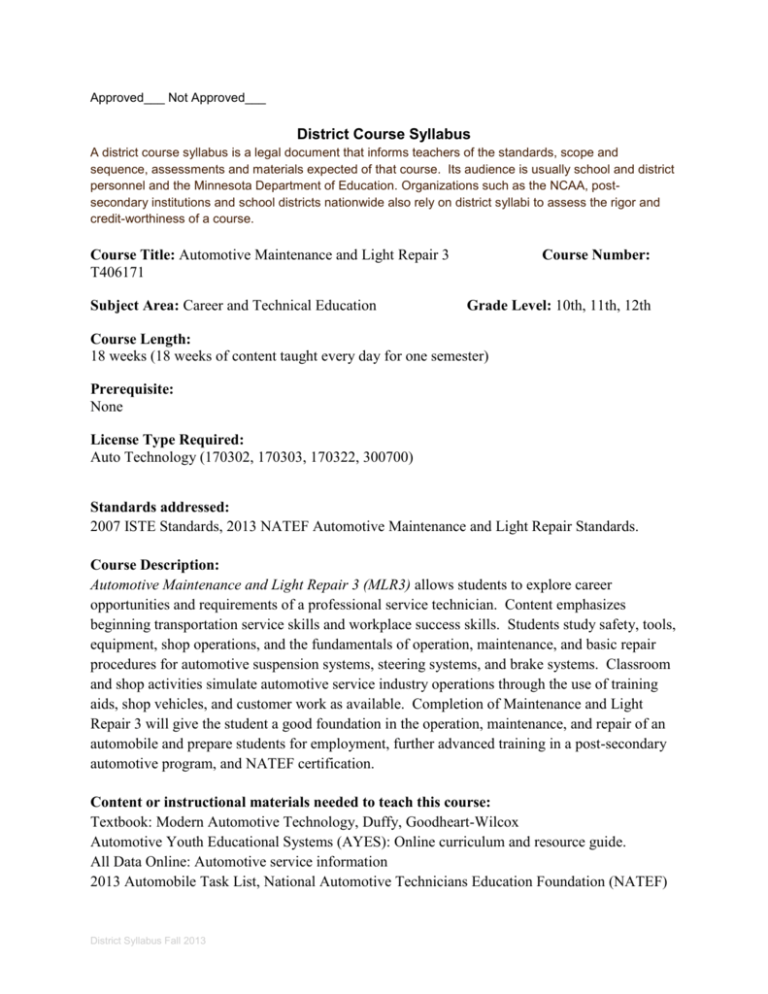
Approved___ Not Approved___ District Course Syllabus A district course syllabus is a legal document that informs teachers of the standards, scope and sequence, assessments and materials expected of that course. Its audience is usually school and district personnel and the Minnesota Department of Education. Organizations such as the NCAA, postsecondary institutions and school districts nationwide also rely on district syllabi to assess the rigor and credit-worthiness of a course. Course Title: Automotive Maintenance and Light Repair 3 T406171 Subject Area: Career and Technical Education Course Number: Grade Level: 10th, 11th, 12th Course Length: 18 weeks (18 weeks of content taught every day for one semester) Prerequisite: None License Type Required: Auto Technology (170302, 170303, 170322, 300700) Standards addressed: 2007 ISTE Standards, 2013 NATEF Automotive Maintenance and Light Repair Standards. Course Description: Automotive Maintenance and Light Repair 3 (MLR3) allows students to explore career opportunities and requirements of a professional service technician. Content emphasizes beginning transportation service skills and workplace success skills. Students study safety, tools, equipment, shop operations, and the fundamentals of operation, maintenance, and basic repair procedures for automotive suspension systems, steering systems, and brake systems. Classroom and shop activities simulate automotive service industry operations through the use of training aids, shop vehicles, and customer work as available. Completion of Maintenance and Light Repair 3 will give the student a good foundation in the operation, maintenance, and repair of an automobile and prepare students for employment, further advanced training in a post-secondary automotive program, and NATEF certification. Content or instructional materials needed to teach this course: Textbook: Modern Automotive Technology, Duffy, Goodheart-Wilcox Automotive Youth Educational Systems (AYES): Online curriculum and resource guide. All Data Online: Automotive service information 2013 Automobile Task List, National Automotive Technicians Education Foundation (NATEF) District Syllabus Fall 2013 The needs of English Language Learners will be addressed in this course by: Collaboration with ELL staff members to adapt instruction according to Individual Educational Plans. Strategies include developing lessons that foster inclusiveness, as well as, differentiate and scaffold instruction to challenge and meet the needs of all ELL students. The needs of students receiving Special Education Services will be addressed in the course by: Special Education needs will be met in the following ways: Allowing time for plenty of practice, conduct student-teacher conferences, break assignments into smaller, more manageable parts, use peer tutors, highlight important directions and key words, give shorter assignments, allow more time for completion, give short, easy to follow instructions, give immediate feedback and lots of encouragement, provide many opportunities for success, use visuals and manipulative materials when available and use cooperative learning strategies. The needs of students who need acceleration will be addressed in this course by: Modifying assignments based on student talent and interest. Gifted and talented students will be offered more in depth course materials allowing them to further develop their understanding of vehicle systems and given additional instruction in troubleshooting and diagnostic procedures. Gifted and talented students will be given opportunities to apply their learning to real world problems by repairing actual customer vehicles as they become available. Gifted and talented will also be given leadership opportunities that will allow them to grow their organizational and leadership skills. Racial equity and culturally relevant teaching will be addressed in this course by: Adapting educational research that affirms children learn best when their culture and language are reflected in the curriculum. Culture shapes our values, attitudes, beliefs, behaviors, and is an intrinsic part of who we are and how we identify ourselves. Students who see their culture represented in the curriculum are more likely to have a higher self-concept, and when students feel good about themselves they are more likely to be open with others and to learning. Integrated learning using technology will be fully utilized by: Providing students with a broad knowledge base in the application of industry based technological concepts. Students will be trained using current industry recognized tools and equipment. Students will also have access to current online service information including both aftermarket and manufacturer specific databases. Quarter 1 - Scope and Sequence Introduction to Automotive Technology - 4 days Introduction to Hand Tools and Shop Equipment - 3 days Introduction to Shop Safety - 5 days District Syllabus Fall 2013 Introduction to Vehicle Service Information - 3 days Tire and Wheel Fundamentals - 2 weeks Wheel Bearing Fundamentals - 1 week Steering System Fundamentals - 2 week Restraint System Fundamentals - 1 week Quarter 2 - Scope and Sequence Suspension System Fundamentals - 2 weeks Wheel Alignment Fundamentals - 1 week General Brake System Fundamentals - 2 weeks Disc Brake System Fundamentals - 2 weeks Drum Brake System Fundamentals - 2 weeks STANDARDS AND BENCHMARKS: From the National Automotive Technology Education Foundation (NATEF) and Automotive Service Excellence (ASE) industry standards. COMPREHENSIVE STANDARD: Integrate knowledge, skills and practices required as a professional automotive service technician. 1.0 Students will demonstrate leadership, citizenship, and teamwork skills required for success in the school, community, and workplace. 2.0 Students will integrate reading, writing, math, and science skills and understand the impact of academic achievement in the workplace. 3.0 Students will demonstrate safety practices for an automotive repair facility. 4.0 Students will demonstrate the proper use of automotive tools and shop equipment. 5.0 Students will demonstrate locating automotive service information. 6.0 Students will demonstrate preparing a vehicle for service. 7.0 Students will properly inspect, test, and service wheel and tire concerns. 8.0 Students will properly inspect, test, and service non-drive wheel bearing concerns. District Syllabus Fall 2013 9.0 Students will properly inspect, test, and service suspension system concerns. 10.0 Students will properly inspect, test, and service steering systems concerns. 11.0 Students will demonstrate preparing a vehicle for a four-wheel alignment. 12.0 Students will properly inspect, test, and service general brake system concerns. 13.0 Students will properly inspect, test, and service disc brake system concerns. 14.0 Students will properly inspect, test, and service drum brake system concerns. STANDARD 1.0 Students will demonstrate leadership, citizenship, and teamwork skills required for success in the school, community, and workplace. BENCHMARKS: The student will: 1.1 Exhibit positive leadership skills. 1.2 Exhibit team building skills. 1.3 Assess situations and apply problem-solving and decision-making skills to client relations in the community and workplace. STANDARD 2.0 Students will integrate reading, writing, math, and science skills and understand the impact of academic achievement in the workplace. BENCHMARKS: The student will: 2.1 Assume responsibility for accomplishing classroom assignments and workplace goals within accepted time frames. 2.2 Develop advanced study skills. 2.3 Demonstrate and use written and verbal communication skills. 2.4 Read and understand technical documents such as regulations, manuals, reports, forms, graphs, charts, and tables. 2.5 Apply the foundations of mathematical principles such as algebra, geometry, and advanced math to solve problems. 2.6 Apply basic scientific principles and methods to solve problems and complete tasks. STANDARD 3.0 District Syllabus Fall 2013 Students will demonstrate safety practices for an automotive repair facility. BENCHMARKS: The student will: 3.1 Identify general shop safety rules and procedures. 3.2 Utilize safe procedures for handling of tools and equipment. 3.3 Identify and use proper placement of floor jacks and jack stands. 3.4 Identify and use proper procedures for safe lift operation. 3.5 Use proper ventilation procedures for working within the shop area. 3.6 Identify marked safety areas. 3.7 Identity the location and the types of fire extinguishers and other fire safety equipment; demonstrate knowledge of the procedures for using fire extinguishers and other fire safety equipment. 3.8 Identify the location and use of eye wash stations. 3.9 Identify the location of the posted evacuation routes. 3.10 Comply with the required use of safety glasses, ear protection, gloves, and shoes during shop activities 3.11 Identify and wear appropriate clothing for shop activities. STANDARD 4.0 Students will demonstrate the proper use of automotive tools and shop equipment. BENCHMARKS: The student will: 4.1 Identify tools and their usage in automotive applications. 4.2 Identify standard and metric designations. 4.3 Demonstrate safe handling and use of appropriate tools. 4.4 Demonstrate proper cleaning, storage, and maintenance of tools and equipment. STANDARD 5.0 Students will demonstrate locating automotive service information. BENCHMARKS: The student will: District Syllabus Fall 2013 5.1 5.2 Identify sources of service information; locate and use paper and electronic service information; locate and use Technical Service Bulletins; demonstrate awareness of special service messages, service campaigns/recalls, vehicle/service warranty applications, and service interval recommendations. Vehicle identification information; locate Vehicle Identification Number and production date code; apply knowledge of Vehicle Identification Number information; demonstrate awareness of other vehicle information labels (such as tire, emission, e STANDARD 6.0 Students will demonstrate preparing a vehicle for service. BENCHMARKS: The student will: 6.1 Identify information needed and the service requested on a repair order. 6.2 Identify purpose and demonstrate proper use of fender covers, mats. 6.3 Demonstrate use of the three C’s (concern, cause, and correction). 6.4 Review vehicle service history. STANDARD 7.0 Students will properly inspect, test, and service wheel and tire concerns. BENCHMARKS: 7.1 7.2 7.3 7.4 7.5 monitoring 7.6 7.7 7.8 operation; Research applicable vehicle and service information, vehicle service history, service precautions, and technical service bulletins. Inspect tire condition; identify tire wear patterns; check for correct size and application (load and speed readings) and adjust air. Rotate tires according to manufacturer’s recommendations. Dismount, inspect, and remount tire on wheel; balance wheel and tire assembly (static and dynamic). Dismount, inspect, and remount tire on wheel equipped with tire pressure system sensor. Inspect tire and wheel assembly for air loss, Repair tire using internal patch. identify and test tire pressure monitoring systems (indirect and direct) for District Syllabus Fall 2013 7.9 verify operation of instrument panel lamps. Demonstrate knowledge of steps required to remove and replace sensors in a tire pressure monitoring system. STANDARD 8.0 Students will properly inspect, test, and service non-drive wheel bearing concerns. BENCHMARKS: The student will: 8.1 Research applicable vehicle and service information, vehicle service history, service precautions, and technical service bulletins. 8.2 Remove, clean, inspect, repack, and install wheel bearings and replace seals; install hub and adjust bearings. 8.3 Replace wheel bearing and race. STANDARD 9.0 Students will properly inspect, test, and service suspension system concerns. BENCHMARKS: The student will: 9.1 Research applicable vehicle and service information, vehicle service history, service precautions, and technical service bulletins. 9.2 Inspect upper and lower control arms, bushings, and shafts. 9.3 Inspect and replace rebound and jounce bumpers. 9.4 Inspect track bar, strut rods/radius arms, and related mounts and bushings. 9.5 Inspect upper and lower ball joints (with or without wear indicators). 9.6 Inspect suspension system coil springs and spring insulators. 9.7 Inspect suspension system torsion bar mounts. 9.8 Inspect and replace front stabilizer bar (sway bar) bushings, brackets, and links. 9.9 Inspect strut cartridge or assembly. 9.10 Inspect front strut bearing and mount. 9.11 Inspect rear suspension system lateral links/arms (track bar), control (trailing) arms. 9.12 Inspect rear suspension system leaf spring(s), spring insulators, shackles, brackets, bushings, center pins/bolts, and mounts. 9.13 Inspect, remove, and replace shock absorbers; inspect mounts and bushings. STANDARD 10.0 District Syllabus Fall 2013 Students will properly inspect, test, and service steering systems concerns. BENCHMARKS: The student will: 10.1 Research applicable vehicle and service information, vehicle service history, service precautions, and technical service bulletins. 10.2 Disable and enable supplemental restraint system (SRS). 10.3 Inspect pitman arm, relay (centerlink/intermediate) rod, idler arm and mountings, and 10.4 steering linkage damper. Inspect tie rod ends, tie rod sleeves, and clamps. 10.5 10.6 10.7 10.8 10.9 10.10 10.11 10.12 10.13 Inspect rack and pinion steering gear inner tie rod ends and bellow boots. Determine proper power steering fluid type; inspect fluid level and condition. Flush, fill, and bleed power steering system. Inspect power steering fluid leakage. Remove, inspect, replace, and adjust power steering pump belt. Inspect and replace power steering hoses and fittings. Replace power steering pump filter(s). Inspect electric power-assisted steering. Describe the function of the power steering pressure switch. STANDARD 11.0 Students will demonstrate preparing a vehicle for a four-wheel alignment. BENCHMARKS: The student will: 11.1 Research applicable vehicle and service information, vehicle service history, service precautions, and technical service bulletins. 11.2 Perform pre-alignment inspection and measure vehicle ride height. STANDARD 12.0 Students will properly inspect, test, and service general brake system concerns. BENCHMARKS: The student will: 12.1 Research applicable vehicle and service information, vehicle service history, District Syllabus Fall 2013 12.2 12.3 12.4 12.5 12.6 12.7 12.8 12.9 12.10 12.11 12.12 12.13 12.14 12.15 service precautions, and technical service bulletins. Describe the procedure for performing a road test to check brake system operation, including and anti-lock brake system (ABS). Measure brake pedal height, travel, and free play (as applicable). Check master cylinder for external leaks and proper operation. Inspect brake lines, flexible hoses, and fittings for leaks, dents, kinks, rust, cracks, bulging, wear, loose fittings and supports. Select, handle, store, and fill brake fluids to proper level. Identify components of the brake warning light system. Bleed and/or flush brake system. Test brake fluid for contamination. Check brake pedal travel with, and without, engine running to verify proper power booster operation. Check vacuum supply (manifold or auxiliary pump) to vacuum-type power booster. Check parking brake cables and components for wear, binding, and corrosion; clean and lubricate, adjust or replace as needed. Check parking brake operation and parking brake indicator light system operation. Check operation of brake stop light system. Identify traction control/vehicle stability control system components. STANDARD 13.0 Students will properly inspect, test, and service disc brake system concerns. BENCHMARKS: The student will: 13.1 Research applicable vehicle and service information, vehicle service history, service precautions 13.2 Remove and clean caliper assembly; inspect for leaks and damage/wear to caliper housing. 13.3 Clean and inspect caliper mounting and slides/pins for operation, wear, and damage. 13.4 Remove, inspect and replace pads and retaining hardware. 13.5 Lubricate and reinstall caliper, pads, and related hardware; seat pads, and inspect for leaks. 13.6 Clean and inspect rotor, measure rotor thickness, thickness variation and lateral runout. 13.7 Remove and reinstall rotor. District Syllabus Fall 2013 13.8 Refinish rotor on vehicle; measure final rotor thickness and compare with specifications. 13.9 Refinish rotor off vehicle; measure final rotor thickness and compare with specifications. 13.10 Retract and re-adjust caliper piston on an integral parking brake system. 13.11 Check brake pad wear indicator. 13.12 Describe importance of operating vehicle to burnish/break-in replacement brake pads according to manufacturer’s recommendations. STANDARD 14.0 Students will properly inspect, test, and service drum brake system concerns. BENCHMARKS: The student will: 14.1 Research applicable vehicle and service information, vehicle service history, service precautions 14.2 Remove, clean, inspect, and measure brake drum diameter. 14.3 Refinish brake drum and measure final drum diameter. 14.4 Remove, clean, and inspect brake shoes, springs, pins, clips, levers, adjusters/selfadjusters, other related brake hardware, and backing support plates; lubricate and reassemble. 14.5 Inspect wheel cylinders for leaks and proper operation; remove and replace as needed. 14.6 Pre-adjust brake shoes and parking brake; install brake drums or drum/hub assemblies and wheel bearings, and make final checks and adjustments. 14.7 Install wheel and torque lug nuts. District Syllabus Fall 2013
